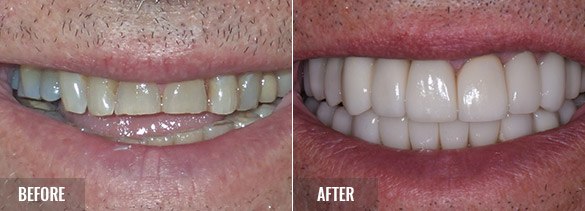Periodontal Disease, also known as Gum Disease, is a serious gum and bone infection that damages the ligaments and bones surrounding teeth. Advanced gum disease is the leading cause of tooth loss in adults. If gum disease is caught in its early stages (gingivitis or mild to moderate periodontitis), it can be managed through non-surgical treatments, such as scaling and root planning at Lepore Comprehensive Dentistry, Dunedin, Florida. However, when moderate to severe periodontitis occurs, causing deeper damage to the gums and bone, osseous surgery may be required to restore health to those areas. This is particularly true when tartar (dental calculus) is so deep below the gum line it’s resting at the level of the supporting bone.
Signs and symptoms of gum disease:
- Swollen, red or bleeding gums
- Loose teeth
- Receding gums (gum tissue that is moving away from the tooth)
- Bad taste in the mouth
- Persistent bad breath
What is osseous periodontal therapy?
Advanced periodontitis can result in bone loss, which can form deep and uneven “pockets” surrounding the teeth. Dr. Lepore or Dr. Dougherty may suggest an osseous periodontal therapy with one of our Periodontists to reduce the pocket depths and restore the areas back to health. Osseous periodontal therapy is an advanced procedure used to treat advanced periodontal disease.
The hardened deposits (calculus) surrounding the teeth and root surfaces are removed during the treatment. The bone is responsible for holding the teeth in place, so it is imperative to recreate a good foundation by reshaping and smoothing the foundation of bone that has become diseased from the constant inflammation caused by bacteria (tartar deposits). Sutures may be placed to allow the area proper time to heal.
When periodontitis has resulted in bone loss, it can form deep, uneven pockets around the teeth. Your doctor may recommend a procedure called Osseous Surgery to reduce the depth of these pockets and help bring the area back to health. These deep pockets accumulate harmful bacteria that can’t be reached by normal cleaning, preventing the gums from ever healing on their own.
To reduce these pockets, first, your doctor will expose the area and use a hand scaler to remove the hardened deposits, called calculus, that surround the teeth and root surface. The bone surrounding the tooth is reshaped and smoothened to recreate a favorable bony architecture.
Next, the area is sutured and allowed to heal. Your doctor will let you know when the area is fully recovered.
Once complete, the pockets surrounding your teeth will be reduced, creating an environment where your mouth has a better chance of recovering from the damage caused by periodontitis.
Osseous periodontal therapy consultation:
After Dr. Lepore or Dr. Dougherty diagnoses advanced periodontal disease, you may be referred to a periodontist, with whom they work in close synergy. Your specialist will complete an initial exam and may take digital diagnostic photos. At your follow-up consultation, the Periodontist will review all treatment options with you, the causes of gum disease, and strategies to prevent future issues.
Goals of osseous periodontal therapy:
- Better home care – it is difficult to brush and floss properly with advanced pocketing. Osseous periodontal therapy reduces the pocket depths
- Bone loss prevention – your immune system attempts to fight off the bacterial infection, but this inflammatory response can lead to bone loss and, in turn, causes the loss of teeth
- Improve your overall health – By reducing bacteria (tartar) in the mouth, you reduce your risk for heart disease, and other systemic conditions
- Eliminate bacteria, reduce pocketing, and smooth damaged bone for gum tissue to reattach to the strong foundational bone
What to expect after osseous periodontal therapy:
- Slight discomfort is common after treatment for about three to five days
- Follow-up appointments with your Periodontist to make sure the treatment was successful
- Increasing how often you see Dr. Lepore, Dr. Dougherty, or your Periodontist once every three months for maintenance cleanings. This helps prevent you from ever needing this treatment again
Call us today with questions
As always, if you have any questions or concerns regarding diagnosed treatment, we encourage you to give our office a call at (727) 608-4690.
Request an Appointment








